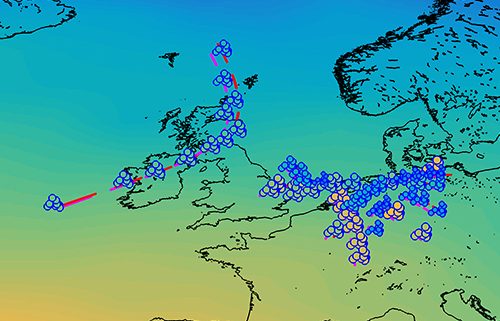ASTRON, the Netherlands institute for radio astronomy, and NLR have recently completed a research experiment to determine whether it is possible to measure the ionosphere with the LOFAR radio telescope. The results of this experiment mark a first step toward establishing a permanent observation system of the ionosphere, aimed at satellite navigation.
The ionosphere is an atmospheric layer containing electrically charged particles, situated some 60 km to 1000 km above the Earth’s surface. This layer disrupts radio signals, which is not only problematic for radio-astronomers striving to detect radio signals from sources in the universe, but also for all satellite navigation receivers on Earth.
The ionosphere delays signals from navigation satellites, which results in position errors of several metres. Such inaccuracy is not problematic for most navigation applications. However, for more demanding applications such as autonomous driving or automated landings, an error of a few meters is far too much.
In 2015 NLR and ASTRON have cooperated to conduct measurements of the ionosphere. ASTRON’s LOFAR radio telescope (currently the largest in the world) was used for this purpose. LOFAR consists of a large number of antenna stations situated across Europe, connected via a fibre optic network. The NLR has installed two satellite navigation-receivers at the LOFAR stations in Exloo and in Steenwijk. In March 2015, an experiment was conducted involving parallel measurements of the ionosphere using the radio telescope and the satellite navigation-receivers.
The goal of the experiment was to determine if LOFAR could be used to measure the state of the ionosphere.
The experiment results show that LOFAR can measure the ionosphere very accurately, but not without help. The observations are relative: LOFAR measured localized differences in the ionospheric electron density (looking in different directions), but cannot determine the absolute density. The GNSS (Global Navigation Satellite System) receivers can measure absolute electron density, but less accurately. By combining the LOFAR measurements with the GNSS observations, it is possible to conduct accurate measurements of the ionosphere covering all of Europe.
The project was successfully completed and the final presentation won an award (5th International colloquium on Scientific and Fundamental Aspects of the Galileo Programme, Braunschweig, October 2015). In a follow-up project, ASTRON and the NLR want to further develop the results into a permanent ionospheric observation system that can serve as an error correction systems for satellite navigation (such as EGNOS). They will also study whether installing permanent GNSS receivers at the LOFAR stations can improve the calibration of the radio telescope for astronomical observations.
This project was financed by ESA, in the framework of the European GNSS Evolution Programme (EGEP).


